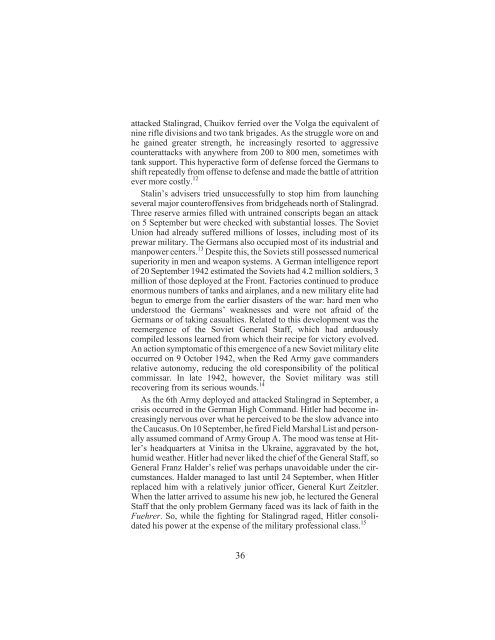SJ Lewis - Strategique.org
SJ Lewis - Strategique.org
SJ Lewis - Strategique.org
Create successful ePaper yourself
Turn your PDF publications into a flip-book with our unique Google optimized e-Paper software.
attacked Stalingrad, Chuikov ferried over the Volga the equivalent of<br />
nine rifle divisions and two tank brigades. As the struggle wore on and<br />
he gained greater strength, he increasingly resorted to aggressive<br />
counterattacks with anywhere from 200 to 800 men, sometimes with<br />
tank support. This hyperactive form of defense forced the Germans to<br />
shift repeatedly from offense to defense and made the battle of attrition<br />
ever more costly. 12<br />
Stalin’s advisers tried unsuccessfully to stop him from launching<br />
several major counteroffensives from bridgeheads north of Stalingrad.<br />
Three reserve armies filled with untrained conscripts began an attack<br />
on 5 September but were checked with substantial losses. The Soviet<br />
Union had already suffered millions of losses, including most of its<br />
prewar military. The Germans also occupied most of its industrial and<br />
manpower centers. 13 Despite this, the Soviets still possessed numerical<br />
superiority in men and weapon systems. A German intelligence report<br />
of 20 September 1942 estimated the Soviets had 4.2 million soldiers, 3<br />
million of those deployed at the Front. Factories continued to produce<br />
enormous numbers of tanks and airplanes, and a new military elite had<br />
begun to emerge from the earlier disasters of the war: hard men who<br />
understood the Germans’ weaknesses and were not afraid of the<br />
Germans or of taking casualties. Related to this development was the<br />
reemergence of the Soviet General Staff, which had arduously<br />
compiled lessons learned from which their recipe for victory evolved.<br />
An action symptomatic of this emergence of a new Soviet military elite<br />
occurred on 9 October 1942, when the Red Army gave commanders<br />
relative autonomy, reducing the old coresponsibility of the political<br />
commissar. In late 1942, however, the Soviet military was still<br />
recovering from its serious wounds. 14<br />
As the 6th Army deployed and attacked Stalingrad in September, a<br />
crisis occurred in the German High Command. Hitler had become increasingly<br />
nervous over what he perceived to be the slow advance into<br />
the Caucasus. On 10 September, he fired Field Marshal List and personally<br />
assumed command of Army Group A. The mood was tense at Hitler’s<br />
headquarters at Vinitsa in the Ukraine, aggravated by the hot,<br />
humid weather. Hitler had never liked the chief of the General Staff, so<br />
General Franz Halder’s relief was perhaps unavoidable under the circumstances.<br />
Halder managed to last until 24 September, when Hitler<br />
replaced him with a relatively junior officer, General Kurt Zeitzler.<br />
When the latter arrived to assume his new job, he lectured the General<br />
Staff that the only problem Germany faced was its lack of faith in the<br />
Fuehrer. So, while the fighting for Stalingrad raged, Hitler consolidated<br />
his power at the expense of the military professional class. 15<br />
36


